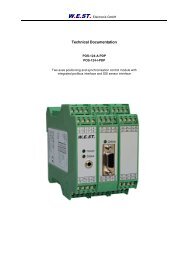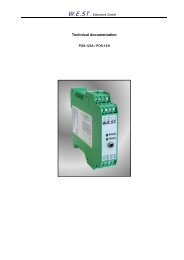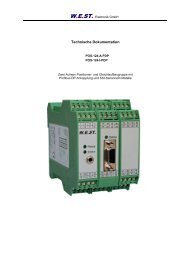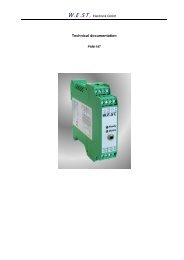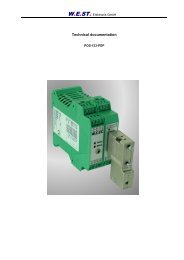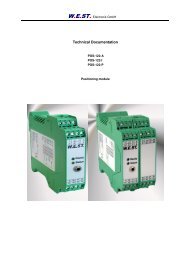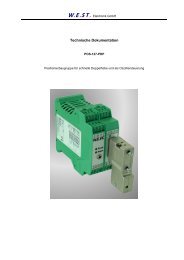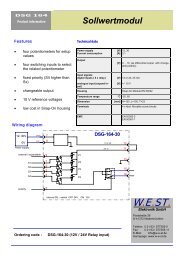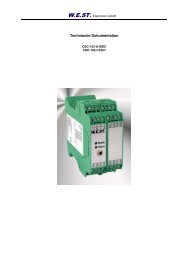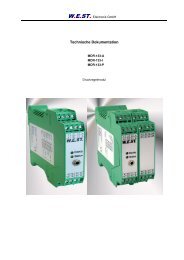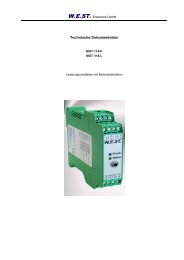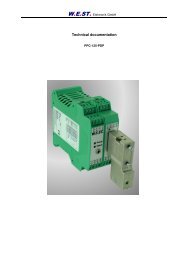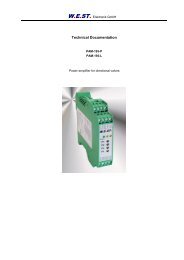PAM-195-GL - W.E.ST. Elektronische Steuerungen e. K.
PAM-195-GL - W.E.ST. Elektronische Steuerungen e. K.
PAM-195-GL - W.E.ST. Elektronische Steuerungen e. K.
You also want an ePaper? Increase the reach of your titles
YUMPU automatically turns print PDFs into web optimized ePapers that Google loves.
W.E.<strong>ST</strong>. Elektronik GmbH<br />
Technical documentation<br />
<strong>PAM</strong>-<strong>195</strong>
W.E.<strong>ST</strong>. Elektronik GmbH<br />
Table of contents<br />
Revisions ..................................................................................................................................................... 3<br />
Ordering code .............................................................................................................................................. 3<br />
Accessories ................................................................................................................................................. 3<br />
General description ..................................................................................................................................... 4<br />
General installation remarks ........................................................................................................................ 5<br />
In- and outputs .................................................................................................................................... 6<br />
LED function ....................................................................................................................................... 6<br />
Block diagram ..................................................................................................................................... 7<br />
Typical wiring ...................................................................................................................................... 8<br />
Technical Data .................................................................................................................................... 9<br />
Dimensions ....................................................................................................................................... 9<br />
General IO description ...................................................................................................................... 10<br />
Power supply .................................................................................................................................. 10<br />
Digital inputs ................................................................................................................................... 10<br />
Digital outputs ................................................................................................................................. 10<br />
Analogue inputs .............................................................................................................................. 11<br />
PWM outputs .................................................................................................................................. 11<br />
Serial interface ................................................................................................................................ 11<br />
Start-up and commissioning guidelines ..................................................................................................... 12<br />
Parameter table ......................................................................................................................................... 13<br />
Parameter description ............................................................................................................................... 15<br />
EAIN (input signal scaling) .............................................................................................................. 15<br />
AINA (simple input selection) .......................................................................................................... 15<br />
AA (acceleration time) .................................................................................................................... 16<br />
MODE (of the linearization)............................................................................................................. 16<br />
CC (characteristic linearization) ...................................................................................................... 16<br />
RCURR (real current input)............................................................................................................. 17<br />
MIN (compensation of the dead zone) ............................................................................................ 18<br />
MAX (maximum output signal) ........................................................................................................ 18<br />
TRIGGER (threshold value of MIN) ................................................................................................ 18<br />
SOLENOIDS (number of solenoids) ............................................................................................... 19<br />
CURRENT (range of the output current) ......................................................................................... 19<br />
DAMPL (dither amplitude)............................................................................................................... 19<br />
DFREQ (dither frequency) .............................................................................................................. 19<br />
PWM (pwm output frequency) ........................................................................................................ 20<br />
PPWM (P-gain of the current compensator) ................................................................................... 20<br />
IPWM (I-gain of the current compensator) ...................................................................................... 20<br />
CMODE (function of the output stage) ............................................................................................ 20<br />
POL (output polarity) ....................................................................................................................... 21<br />
SENS (sensor monitoring) .............................................................................................................. 21<br />
SAVE (data storing in EEPROM) .................................................................................................... 21<br />
LOADBACK (copy of the EEPROM into the active RAM) ............................................................... 21<br />
DEFAULT (parameter reset) ........................................................................................................... 21<br />
PROCESS DATA (monitoring) ........................................................................................................ 22<br />
Appendix: Remote control ......................................................................................................................... 23<br />
Appendix: S versions ................................................................................................................................. 24<br />
S1 (two flow ranges) ....................................................................................................................... 24<br />
S2 (separate enable signals) .......................................................................................................... 24<br />
S3 (power limitation) ....................................................................................................................... 24<br />
Remarks .................................................................................................................................................... 25<br />
Page 2 of 25
Revisions<br />
W.E.<strong>ST</strong>. Elektronik GmbH<br />
Date<br />
Module Version/<br />
Revision<br />
Comment<br />
02.01.2006 13 Hardware based on Digi<strong>PAM</strong><br />
Additional functions:<br />
improved parameter calculation; eliminated rounding error<br />
improved solenoid current control (CAUTION: the dither<br />
05.12.2006 14-rev 15<br />
amplitude have to be reduced (depending of the valve dynamics))<br />
increased baud rate<br />
remote control<br />
intensity of the yellow LED is related to the current output<br />
24.02.2007 14-rev 16<br />
Hardware protection of the power stage<br />
Ordering code<br />
<strong>PAM</strong>-<strong>195</strong> - for directional valves<br />
Alternative products<br />
<strong>PAM</strong>-196 - two independent channels for pressure or throttle valves<br />
<strong>PAM</strong>-197 - with switching inputs (eight selectable command values)<br />
* = Version number, for ordering not necessary. Changes of the last digit (13 to 14) indicate technical improvements<br />
at 100% compatibility. Changes from 13 to 20 indicate significant technical improvements. In<br />
this case check the documentation about the parameter and wiring.<br />
Accessories<br />
RS232-SO - programming cable with RS232C interface<br />
USB-SO - programming cable with USB interface<br />
W.E.<strong>ST</strong>. Elektronik GmbH<br />
Poststraße 26<br />
D-41372 Niederkrüchten<br />
Fax.: +49 (0) 2163 57 73 55 - 11<br />
Homepage: www.w-e-st.de or www.west-electronics.com<br />
EMAIL: info@w-e-st.de<br />
Date: 20.12.2009<br />
Revision: 10<br />
The right of changes are reserved.<br />
Page 3 of 25
General description<br />
W.E.<strong>ST</strong>. Elektronik GmbH<br />
This module is used for the control of proportional valves with two solenoids (directional valves). Various<br />
adjustable parameters enable an optimized adaptation to the respective valve. This power amplifier is inexpensive<br />
and a space-saving solution.<br />
The amplifier is controlled by a ±10 V (or 4... 20 mA with 12 mA for the neutral position) signal. The output<br />
current is closed loop controlled and therefore independent from the supply voltage and the solenoid resistance.<br />
Ramps, MIN and MAX, the DITHER (frequency and amplitude) and the PWM frequency are programmable<br />
within a wide range. In addition the valve characteristic can be linearized via 10 XY-points per direction.<br />
For example: by use of pressure valves a linear behaviour between input signal and pressure can be<br />
reached.<br />
The adjustment via RS232C is simple and easy. A standard terminal program, special windows application<br />
software (WPC-300, download from our homepage) can be used.<br />
Typical applications: Control of proportional valves<br />
Features<br />
Power amplifier for proportional directional valves<br />
Compact housing<br />
Digital reproducible adjustments<br />
Characteristic linearization via 10 XY-points per direction<br />
Free parametering of ramps, MIN und MAX current, Dither (frequency, am-<br />
plitude) and PWM frequency<br />
Current range (per software adaptable): 1 A, 1,6 A and 2,6 A<br />
Simple and application orientated parameter settings<br />
Failure monitoring<br />
Adjustments via RS232C interface<br />
Page 4 of 25
General installation remarks<br />
Explanation of terms and notes on safety<br />
Terms:<br />
W.E.<strong>ST</strong>. Elektronik GmbH<br />
w: command signal<br />
u: internal signal<br />
c: internal signal<br />
ia, ib: output current (not scaled, only for information)<br />
Mounting instructions<br />
This module is for the installation provided in shielded electromagnetic compatibility housing (EMC conform).<br />
All cables operating outside have to be screened. A complete shielding is presupposed. It is also presupposed,<br />
that no strong electrical disturbances near the module are installed.<br />
Typical mounting area: 24V control signal area (near PLC)<br />
By the arrangement of the electrical cabinet a separation between power part (and power cables) and<br />
signal part must be taken in consideration. Experience shows us that the area next to the PLC (24 V<br />
area) is suitable. All digital and analogue inputs and outputs have filters and an over voltage protection. In<br />
case of correct wiring and shielding all EMC demands are fulfilled. If there are nevertheless any problems,<br />
please send us detailed sketches of mounting and wiring. We will look after this problem immediately.<br />
Even if all EMC-norms are fulfilled, technical problems in special cases are possible. Our experience has<br />
shown us that most of these problems are caused in the physical conditions of the cables. If everything is<br />
shielded continuously and configured correctly, no problems have to be expected.<br />
ATTENTION!<br />
ATTENTION!<br />
Due to electrical disturbances, failure at components as well as software faults can cause<br />
in individual cases uncontrolled movements at the drive. Appropriate safety precautions<br />
have to be considered during the engineering.<br />
Connection and start up of the module may only be allowed by qualified persons<br />
who have, because of education, experience and instruction, sufficient<br />
acknowledge on relevant directives and approved technical rules. Please<br />
read and follow the operating instructions carefully. In case of non observance<br />
of the instruction the guaranty and liability claim expires.<br />
Page 5 of 25
In- and outputs<br />
LED function<br />
W.E.<strong>ST</strong>. Elektronik GmbH<br />
Terminal Description of the analogue inputs and outputs<br />
PIN 9/10 and External command value (V), range ±100 % corresponds to ±10 V<br />
PIN 14/13 or 4… 12… 20 mA<br />
PIN 1/2 and<br />
PIN 3/4<br />
Terminal points for the solenoids. PIN 3/4 A-solenoid, PIN 1/2 B-solenoid<br />
Terminal Description of the digital inputs and outputs<br />
PIN 15 Enable input:<br />
This digital input signal initializes the application. The power output is active and the<br />
READY signal indicates that all components are working correctly.<br />
PIN 6 Free for user specified function:<br />
PIN 5 READY output:<br />
General operational, ENABLE is active and there is no input error (by use of 4… 20<br />
mA input) or solenoid error. This output corresponds with the green LED.<br />
LEDs Description of the LED function<br />
GREEN Corresponding with the READY output.<br />
OFF: No power supply or ENABLE is not activated<br />
ON: System is ready<br />
FLASHING: A failure is detected.<br />
(4… 20 mA input) signal is out of the range or<br />
short cut / broken cable to the solenoids<br />
YELLOW The intensity indicates the rate of output current.<br />
Page 6 of 25
Block diagram<br />
Power supply<br />
<strong>PAM</strong>-<strong>195</strong>-*<br />
Voltages input<br />
3,5 mm Cinch<br />
9<br />
12 /24 V<br />
0V<br />
7<br />
8<br />
24 V<br />
Ramp<br />
DC<br />
0 V<br />
RS232 C<br />
9600 Baud<br />
10<br />
DC<br />
8 V<br />
5 V<br />
CMD signal aa:i x<br />
i = 1|2|3|4<br />
x = 0..60000<br />
+<br />
-<br />
10 V... -10 V<br />
W<br />
14<br />
W.E.<strong>ST</strong>. Elektronik GmbH<br />
3<br />
ia<br />
4<br />
A<br />
A-solenoid<br />
CMODE = OFF<br />
pwm x <br />
x = 80..3900<br />
ipwm x <br />
x = 2..100<br />
ppwm x <br />
x = 0..7<br />
dfreq:i x <br />
i = A | B<br />
x = 60..400<br />
dampl:i x <br />
i = A | B<br />
+<br />
-<br />
13<br />
Current input<br />
U C<br />
Linearisation<br />
CC:i x y<br />
9<br />
2<br />
ib<br />
CMD signal<br />
10<br />
B<br />
4... 20 mA<br />
1<br />
Page 7 of 25<br />
11<br />
B-solenoid<br />
x = 0..1500<br />
3<br />
A-solenoid<br />
min:i x <br />
i = A | B<br />
x = 0..5000<br />
max:i x <br />
i = A | B<br />
x = 5000..10000<br />
4<br />
12 8 V ref.<br />
Power stage<br />
2<br />
General commands<br />
Control program<br />
B-solenoid<br />
6<br />
24 V input<br />
not used<br />
free for S-modifications<br />
CMODE = ON<br />
5<br />
12 / 24 V Ready output<br />
CONFIGURATION<br />
aina x (x = V | C)<br />
mode x (x = ON|OFF)<br />
cmode x (x= ON|OFF)<br />
DIAGNO<strong>ST</strong>ICS<br />
din <br />
xq, xp <br />
wq, qp <br />
z <br />
SUPPORT<br />
save <br />
loadback <br />
help <br />
para <br />
PE via DIN-RAIL<br />
15<br />
Enable<br />
24 V input
Typical wiring<br />
Analoger Sollwert (-10... 10V)<br />
Analogue command signal (-10... 10V)<br />
+ -<br />
W.E.<strong>ST</strong>. Elektronik GmbH<br />
Schirm /<br />
Screen<br />
PE<br />
1<br />
5<br />
9<br />
13<br />
2<br />
6<br />
10<br />
14<br />
Page 8 of 25<br />
3<br />
7<br />
11<br />
0V<br />
15<br />
4<br />
8<br />
12<br />
16<br />
V ref.<br />
Enable<br />
Magnet B<br />
Solenoid B<br />
Magnet A<br />
Solenoid A<br />
12 V / 24 V<br />
0V<br />
Spannungsversorgung<br />
Power Supply
Technical Data<br />
Power supply<br />
Current consumption<br />
External fuse<br />
Dimensions<br />
WIDTH (see technical data)<br />
W.E.<strong>ST</strong>. Elektronik GmbH<br />
[VDC]<br />
[mA]<br />
[A]<br />
Digital inputs [V]<br />
[V]<br />
Digital outputs [V]<br />
[V]<br />
Analogue inputs (sensor and command<br />
signals)<br />
Resolution<br />
[V]<br />
[mA]<br />
[%]<br />
Page 9 of 25<br />
10… 30 (incl. ripple)<br />
10 V<br />
logic 0: < 2 V<br />
logic 1: > 10 V (50 mA)<br />
-10… 10; 100 kOhm<br />
4… 12… 20; 390 Ohm<br />
0,025 (incl. oversampling)<br />
Reference voltages [V] 8; 10 mA max.<br />
PWM outputs<br />
max. load<br />
Frequency<br />
Sample time (signal conditioning)<br />
Sample time (current control loop)<br />
Interface<br />
[A]<br />
[Hz]<br />
[ms]<br />
[ms]<br />
1,0, 1,6 or 2,6 (per software switchable)<br />
(alternative adjustable in mA steps)<br />
100… 7700 adjustable PWM frequency<br />
1<br />
0,1667<br />
RS 232C, 9600 Baud, 1 stopbit, No parity, Echo<br />
Mode<br />
Housing Snap-On Module EN 50022<br />
Polyamide PA 6.6<br />
Combustibility class V0… V2 (UL94)<br />
Protection class<br />
Temperature range<br />
Humidity<br />
[IP]<br />
[°C]<br />
[%]<br />
Dimensions (width) [mm] 25,5<br />
20<br />
-20… 60<br />
General IO description<br />
Power supply<br />
W.E.<strong>ST</strong>. Elektronik GmbH<br />
This module is designed for 10… 30 VDC (typical 12 V or 24 V) of a power supply. This power supply<br />
must correspond to the actual EMC standards.<br />
All inductivities at the same power supply (relays, valves …) must be provided with an over voltage protection<br />
(varistors, free-wheel diodes …).<br />
It is recommended to use a regulated power supply (linear or switching mode) for the supply of the module<br />
and the sensors. These power supplies have a clearly lower internal resistance in comparison with<br />
non regulated power supplies and therefore a better spurious rejection.<br />
Power supply : 10… 30 VDC, incl. ripple<br />
Power consumption: 100 mA + solenoid current consumption<br />
External protection: 5 A fast<br />
Digital inputs<br />
ATTENTION: Without an external fuse and in case of a continual short-circuit the<br />
module can be destroyed in spite of all internal protections.<br />
The digital inputs are designed for a voltage level of 12 V and 24 V. The typical connections to the PLC<br />
will not be screened if the modules are arranged carefully and with short cable lengths. As common potential<br />
0V (PIN 4) is used.<br />
All inputs are protected with suppressor diodes and RC-filters against transient overshoots.<br />
Low level: < 4 V<br />
High level: > 10 V<br />
Current: < 0,1 mA<br />
Digital outputs<br />
The digital outputs are designed for a voltage level of 12 V and 24 V. The typical connections to the PLC<br />
will not be screened if the modules are arranged carefully and with short cable lengths. As common potential<br />
0V (PIN 4) is used.<br />
All outputs are protected with suppressor diodes and RC-filters against transient overshoots.<br />
Low level: < 4 V<br />
High level: > 10 V<br />
Current: max. 50 mA (with load of 200 Ohm)<br />
Page 10 of 25
Analogue inputs<br />
W.E.<strong>ST</strong>. Elektronik GmbH<br />
The analogue inputs are designed for a maximum voltage range of 10 V. The voltage input is typically<br />
±10 V and the current input is 4… 20 mA with 12 mA for the center position of the directional valve.<br />
The inputs are protected with suppressor diodes (level 33 V) and RC-filter against transient overshoots.<br />
All analogue inputs must be screened.<br />
Differential input:<br />
Voltage level: bipolar ±10 V (PIN 9 / PIN 10 and parallel PIN 14 / PIN 13)<br />
unipolar 0… 10 V to PIN 9 / PIN 10 and separate 0… 10 V to PIN 13 /<br />
PIN 14<br />
input resistance: 100 k<br />
Current level: unipolar 4… 20 mA (PIN 9 to PIN 10)<br />
input resistance: app. 390<br />
Cable break down are monitored via the READY output and a flashing<br />
green LED.<br />
PWM outputs<br />
The output current is controlled via closed loop PWM current controller with PI characteristics. For high<br />
flexibility PWM frequency, dither frequency, dither amplitude and the PI compensator are free configurable.<br />
Cable break down and short cuts are monitored via the READY output and a flashing green READY<br />
LED.<br />
The outputs are protected with suppressor diodes (level 33 V) and RC-filter against transient overshoots.<br />
PWM:<br />
Output current: max. 2,6 A 1<br />
Frequency: 100… 7700 Hz<br />
Serial interface<br />
The serial interface is chosen for the parametering with a PC or a notebook. A suitable cable of 3,5mm<br />
JISC-6560 plug to 9pol. RS232 (PC compatible) can be bought under RS232-SO.<br />
You can parameterize our modules with each terminal program. However, by use of our application software<br />
WPC-300 you have enlarged functions and therefore it is preferable.<br />
Download: WWW.WE<strong>ST</strong>-ELECTRONICS.COM or WWW.W-E-<strong>ST</strong>.DE<br />
Features:<br />
Table orientated parametering<br />
Saving and loading of the parameter sets<br />
Process data monitoring<br />
Oscilloscope for dynamical optimization of the control parameters<br />
Terminal window for flexible data input<br />
1 The output current can be adjusted in % of the rated current or directly in mA. In case of mA adjustment, the “cur-<br />
rent” command should not be used.<br />
Page 11 of 25
W.E.<strong>ST</strong>. Elektronik GmbH<br />
Start-up and commissioning guidelines<br />
1. The module must be mounted and wired with attentions to EMC requirements. A star orientated<br />
ground connection should be used when other power consumers are sharing the same power<br />
supply. Following points have to be taken in account for wiring:<br />
Signal cable and power cable have to be wired separately.<br />
Analogue signal cables must be screened.<br />
Other cables should be screened in case of strong electrical disturbance (power relays,<br />
frequency controlled power driver) and cable lengths > 3m. With high frequency EMI inexpensive<br />
ferrite elements can be used. In this typical configuration of installation (see<br />
point 2 to 4), no extra step should be taken in consideration.<br />
2. By the arrangement of the electrical cabinet a separation between the power part (and power<br />
cables) and signal part must be taken in consideration. Experience shows us that the area next to<br />
the PLC (24 V area) is suitable.<br />
3. Low impedance between PE “protected earth” and DIN-Rail should be used. Transient interference<br />
voltages at the terminals are discharged via DIN-Rail to the local PE. The screens have to<br />
be connected directly next to the module via PE terminals.<br />
4. The power supply should be carried out voltage regulated (i. e. PWM controlled). The low impedance<br />
of controlled power supplies facilitates improved interference damping. Therefore the signal<br />
resolution will be increased. Switched inductance (relays and solenoids) operating from the same<br />
power supply has to be damped by surge protection elements directly by the inductance.<br />
5. No plugs with freewheeling diodes, LEDs or other electronics should be used. The freewheeling<br />
diode is integrated in the power stage of the module.<br />
Caution: Using of electronic components in the plugs will destabilize the current<br />
control loop. The power stage can be damaged.<br />
Page 12 of 25
Parameter table<br />
W.E.<strong>ST</strong>. Elektronik GmbH<br />
Commands Parameter Defaults Units Description<br />
ain a b c x<br />
a= -10000… 10000<br />
b= -10000… 10000<br />
c= -10000… 10000<br />
x= V|C<br />
: 10000<br />
: 10000<br />
: 0<br />
: V<br />
-<br />
-<br />
0,01%<br />
-<br />
Page 13 of 25<br />
…<br />
Analogue output selection. W and X for the inputs and V = voltage,<br />
C = current. With the parameters a, b and c the inputs can be scaled<br />
(output = a / b * (input - c)).<br />
Because of the programming of the x-value (x = C) the corresponding<br />
input will be switched over to current automatically.<br />
aina x x= V|C V - Simple input selection: V is used for voltages input (+/- 10 V) and C<br />
is used for current input (4… 20 mA).<br />
aa:i x i= 1… 4<br />
x= 5… 60000<br />
: 100<br />
ms<br />
Ramp times depending on the relevant quadrant. 1 and 2 are used<br />
for solenoid A and 3 and 4 are used for solenoid B.<br />
mode x x= on|off off - Activation or deactivation of the linearization defined by the CC<br />
command.<br />
cc:i x y i= -10… 10<br />
x= -10000… 10000<br />
y= -10000… 10000<br />
-<br />
-<br />
-<br />
-<br />
0,01%<br />
0,01%<br />
Characteristic linearization.<br />
rcurr x x= on|off off - Real current input. MIN and MAX will be typed in, in mA. If rcurr = on;<br />
the command “current” should not be used.<br />
min:i x i= A|B<br />
x= 0… 5000<br />
max:i x i= A|B<br />
x= 300… 10000<br />
:A 0<br />
:B 0<br />
:A 10000<br />
:B 10000<br />
0,01%<br />
0,01%<br />
0,01%<br />
0,01%<br />
Deadband compensation of positive overlapped proportional valves.<br />
Good adjustment will increase positioning accuracy.<br />
Maximum output range for adapting control range to maximum flow<br />
range.<br />
trigger x x= 0… 2000 200 0,01% Point to activate the deadband compensation (min). Also useful for<br />
reduced sensitivity in position with control valves.<br />
solenoids x x= 1… 2 2 - Number of used solenoids.<br />
2-for directional valves,<br />
1-for pressure or throttle valves 2 .<br />
current x x= 0… 2 0 - Output current range.<br />
0 = 1,0 A range<br />
1 = 1,6 A range<br />
2 = 2,6 A range<br />
dampl x x= 0… 3000 400 0,01% Parametering of the dither amplitude in 0,01 % units of the nominal<br />
current range. Typical values between 500 and 1200 (with 700 we<br />
always had good experience).<br />
dfreq x x= 60… 400 120 Hz Preset of the dither frequency<br />
pwm x x= 100… 7700 2600 Hz Preset of the PWM frequency<br />
ppwm x x= 1… 30 7 - P-gain for control dynamics of the current control loop. Changing of<br />
these parameters should only be done by expert know how. A higher<br />
P-gain increases the control dynamics of the current control and also<br />
the effect of the dither adjustment<br />
ipwm x x= 1… 100 40 - I-gain for control dynamics of the current control loop. Changing of<br />
these parameters should only be done by expert know how<br />
cmode x x= on|off on - Function of the output stage:<br />
OFF: function for closed loop positioning drives,<br />
ON: standard and for only one return line by two solenoids (HAWE<br />
valves).<br />
pol x x= +|- - - Changing of the output polarity.<br />
sens x x= on|off on - Activation of the sensor and internal failure monitoring.<br />
2 Attention: in case of current input and throttle/pressure solenoids the range of 12… 20 mA is used only.
W.E.<strong>ST</strong>. Elektronik GmbH<br />
Commands Parameter Defaults Units Description<br />
save - - - Storing the programmed parameter in E²PROM.<br />
loadback - - - Reloading the parameter from E²PROM in working RAM<br />
din - - - Status of the digital inputs.<br />
w, c, u, ia, ib - - - Actual signals: command value, actual value, process data…<br />
default - - - Preset values will be set.<br />
Page 14 of 25
Parameter description<br />
EAIN (input signal scaling)<br />
W.E.<strong>ST</strong>. Elektronik GmbH<br />
Commands Parameter Defaults Units<br />
ain:i a b c x i= W|X<br />
a= 0… 10000<br />
b= 0… 10000<br />
c= -10000… 10000<br />
x= V|C<br />
: 1000<br />
: 1000<br />
: 0<br />
: V<br />
THIS COMMAND WILL BE IMPLEMENTED IN FUTURE VERSION 3 .<br />
Page 15 of 25<br />
-<br />
-<br />
0,01%<br />
-<br />
With this command each input can be scaled individually. For the scaling function the following linear<br />
equation is taken.<br />
y<br />
a<br />
b<br />
x<br />
x is the input signal and y is the output signal.<br />
At first the offset (c) will be subtracted (in 0,01% units) from the input signal, then the signal will be multiplied<br />
with factor a / b. a and b should always be positive. With these both factors every floating-point value<br />
can be simulated (for example: 1.345 = 1345 / 1000).<br />
With the x parameter value the internal measuring resistance for the current measuring (0… 20 mA or<br />
4… 20 mA) will be activated (V for voltages input and C for current input).<br />
AIN:xx a b c x<br />
i with voltage: AIN:i 1000 1000 0 V<br />
i with current: AIN:i 1250 1000 2000 C<br />
AINA (simple input selection)<br />
c<br />
Commands Parameter Defaults Units<br />
aina x x= V|C V -<br />
Simple input selection by presetting the values a, b, c and x of the AIN command.<br />
V = voltage input ± 10 V<br />
C = current input 4… 20 mA, 12 mA is the neutral position (0% output signal).<br />
3 This scaling function will be implemented in version 15.
AA (acceleration time)<br />
W.E.<strong>ST</strong>. Elektronik GmbH<br />
Commands Parameter Defaults Units<br />
aa:i x i= 1|2|3|4<br />
x= 5… 60000<br />
100<br />
This parameter is set in ms 4 .<br />
The ramp function is defined by the four quadrants for extending and retracting of a hydraulic axis.<br />
aa:1 acceleration (ramp up) for the A solenoid output<br />
aa:2 deceleration (ramp down) for the A solenoid output<br />
aa:3 acceleration (ramp up) for the B solenoid output<br />
aa:4 deceleration (ramp down) for the B solenoid output<br />
MODE (of the linearization)<br />
Commands Parameter Defaults Units<br />
mode x x= ON|OFF OFF -<br />
This command ist used for activation or deactivation of the characteristic linearization defined by the CC<br />
command. To test the linearization it can be useful to deactivate this function.<br />
CC (characteristic linearization)<br />
Commands Parameter Defaults Units<br />
cc:i x y i= -10… 10<br />
x= -10000… 10000<br />
y= -10000… 10000<br />
-<br />
-<br />
-<br />
Page 16 of 25<br />
ms<br />
0,01%<br />
0,01%<br />
A user defined characteristic can be used by this function.<br />
The characteristic linearization defines positive values for the linearization of channel A and negative values<br />
for channel B. Ten XY-points per solenoid are possible.<br />
Every curve function is calculated according to the equation (linear interpolating between the points: y=(xx1)*(y1-y0)/x1-x0)+y1)<br />
.<br />
With the command MODE ON|OFF the linearization function can be activated or deactivated. The characteristic<br />
between the input and the function CC can be considered by the process variables U to C in the<br />
monitor / oscilloscope.<br />
Caution: The table must be filled completely always from the top (10 then 9 then 8… and/or -10 then -9<br />
then -8…). The lower unused range can be filled with cc:i 0 0.<br />
4 A small deviation by long ramp times is possible. Typical failure by 20 seconds are: app. 0,02% (4 ms). This devia-<br />
tion is caused by the internal limited variables.
Example:<br />
Flow characteristics as a square function<br />
W.E.<strong>ST</strong>. Elektronik GmbH<br />
Command X-value Y-value<br />
CC: -10 -10000 -10000<br />
10000<br />
CC: -9 -9000 -8100<br />
CC: -8<br />
CC: -7<br />
-8000<br />
-7000<br />
-6400<br />
-4900<br />
7500<br />
CC: -6 -6000 -3600<br />
CC: -5 -5000 -2500<br />
5000<br />
CC: -4 -4000 -1600<br />
CC: -3<br />
CC: -2<br />
-3000<br />
-2000<br />
-900<br />
-400<br />
2500<br />
CC: -1 -1000 -100<br />
CC: 0 0 0<br />
0<br />
CC: 1 1000 100 -10000 -7500 -5000 -2500 0 2500 5000 7500 10000<br />
CC: 2<br />
CC: 3<br />
2000<br />
3000<br />
400<br />
900<br />
-2500<br />
CC: 4 4000 1600<br />
CC: 5 5000 2500<br />
-5000<br />
CC: 6 6000 3600<br />
CC: 7<br />
CC: 8<br />
7000<br />
8000<br />
4900<br />
6400<br />
-7500<br />
CC: 9 9000 8100<br />
CC: 10 10000 10000 -10000<br />
Page 17 of 25<br />
Reihe1<br />
Flow characteristics for compensation of non linear valve characteristics with limitation of the output in B.<br />
Command X-value Y-value<br />
CC: -10 -10000 -6000<br />
10000<br />
CC: -9 -8100 -6000 -9000<br />
CC: -8<br />
CC: -7<br />
-6400<br />
-4900<br />
-6000<br />
-6000<br />
7500<br />
CC: -6 -3600 -6000<br />
CC: -5 -2500 -5000<br />
5000<br />
CC: -4 -1600 -4000<br />
CC: -3<br />
CC: -2<br />
-900<br />
-400<br />
-3000<br />
-2000<br />
2500<br />
CC: -1 -100 -1000<br />
CC: 0 0 0<br />
0<br />
CC: 1 100 1000 -10000 -7500 -5000 -2500 0 2500 5000 7500 10000<br />
CC: 2<br />
CC: 3<br />
400<br />
900<br />
2000<br />
3000<br />
-2500<br />
CC: 4 1600 4000<br />
CC: 5 2500 5000<br />
-5000<br />
CC: 6 3600 6000<br />
CC: 7<br />
CC: 8<br />
4900<br />
6400<br />
7000<br />
8000<br />
-7500<br />
CC: 9 8100 9000<br />
CC: 10 10000 10000 -10000<br />
RCURR (real current input)<br />
Commands Parameter Defaults Units<br />
rcurr x<br />
x= ON|OFF OFF -<br />
This parameter is activating the real current function for MIN and MAX input.<br />
If rcurr = on; the minimum and maximum values are defined in mA.<br />
Reihe1
MIN (compensation of the dead zone)<br />
MAX (maximum output signal)<br />
TRIGGER (threshold value of MIN)<br />
W.E.<strong>ST</strong>. Elektronik GmbH<br />
Commands Parameter Defaults Units<br />
min:i x<br />
max:i x<br />
trigger x<br />
i= A|B<br />
x= 0… 5000<br />
x= 300… 10000<br />
x= 0… 2000<br />
-<br />
0<br />
10000<br />
200<br />
Page 18 of 25<br />
-<br />
0,01%<br />
0,01%<br />
0,01%<br />
With this command, the output signal is adjusted to the valve characteristics.<br />
MIN:B<br />
MAX:B<br />
ATTENTION: If the MIN value is set too high, it influences the minimal velocity, which<br />
cannot be adjusted any longer. In extreme case this causes to an oscillating around the<br />
closed loop controlled position.<br />
Output<br />
TRIGGER<br />
standard deadband<br />
compensation<br />
Input<br />
MAX:A<br />
MIN:A
SOLENOIDS (number of solenoids)<br />
W.E.<strong>ST</strong>. Elektronik GmbH<br />
Commands Parameter Defaults Units<br />
solenoids x<br />
x= 1… 2 2 -<br />
If this module is used with a throttle or pressure valve solenoid A should be used only.<br />
This command is used to switch off the internal monitoring of solenoid B.<br />
Solenoids = 1 - throttle or pressure valve (See Note 2)<br />
Solenoids = 2 - directional valves<br />
CURRENT (range of the output current)<br />
Commands Parameter Defaults Units<br />
current x<br />
x= 0, 1, 2 0 -<br />
Selection of the output current range: 0 = 1,0 A range, 1 = 1,6 A range and 2 = 2,6 A range.<br />
DAMPL (dither amplitude)<br />
Commands Parameter Defaults Units<br />
dampl x<br />
x= 0… 3000 400 0,01%<br />
Dither amplitude. Typical values between 500 and 1200 (good experience were made with 700) 5 .<br />
DFREQ (dither frequency)<br />
Commands Parameter Defaults Units<br />
dfreq x<br />
x= 60… 400 120 Hz<br />
Dither frequency. Typical values are between 60 and 200 (good experience were made with 125).<br />
The dither amplitude and the dither frequency are adjustable. With the dither setting the valve hysteresis<br />
can be reduced clearly. The dates for the dither setting can often be taken from the valve dates.<br />
The dither amplitude should be as high as possible, but the drive should not vibrate.<br />
Caution: Too high dither amplitude can lead to an increased attrition (the friction in the<br />
valve reduces a short start phase).<br />
Caution: If the PWM frequency is lower than 500 Hz, the dither amplitude should be set to<br />
zero. In this case the low PWM frequency is used to reduce the valve hysteresis<br />
5 The current loop compensator is improved in software version 14. The amplitude has to be reduced again older ver-<br />
sions.<br />
Page 19 of 25
PWM (pwm output frequency)<br />
W.E.<strong>ST</strong>. Elektronik GmbH<br />
Commands Parameter Defaults Units<br />
pwm x<br />
x= 100… 7700 2600 Hz<br />
PWM frequencies of ≥2000 Hz improve the current loop dynamics. PWM frequencies in the range of<br />
100… 500 Hz will be used for low dynamic valves with high hysteresis. In this case, DAMPL must be<br />
zero.<br />
Caution: In some cases PPWM and IPWM should be adapted for the low current loop dynamics.<br />
PPWM (P-gain of the current compensator)<br />
IPWM (I-gain of the current compensator)<br />
Commands Parameter Defaults Units<br />
ppwm x<br />
ipwm x<br />
x= 1… 30<br />
x= 1… 100<br />
7<br />
40<br />
PI-compensator used for the current control function. Changes should be only done with good experience<br />
in optimizing of current loops.<br />
In cases of a PWM-frequency >2500 Hz; PPWM can be increased to 7… 15 (typical values: PPWM = 7<br />
and IPWM = 40).<br />
In cases of a PWM-frequency
POL (output polarity)<br />
W.E.<strong>ST</strong>. Elektronik GmbH<br />
Commands Parameter Defaults Units<br />
pol x x= +|- + -<br />
The output polarity of the controller can be switched over.<br />
SENS (sensor monitoring)<br />
Commands Parameter Defaults Units<br />
sens x x= ON|OFF ON -<br />
The sensor monitoring can be activated. The output current to the solenoids and the input signal (in case<br />
of 4… 20 mA) are monitored.<br />
SAVE (data storing in EEPROM)<br />
Commands Parameter Defaults Units<br />
save - - -<br />
Every parameter change is immediately active but only saved in RAM. For permanent storing in<br />
EEPROM the command SAVE is used to copy the parameter from RAM into EEPROM memory.<br />
LOADBACK (copy of the EEPROM into the active RAM)<br />
Commands Parameter Defaults Units<br />
loadback - - -<br />
With this command, the data will be written back from EEPROM to RAM. This is helpful when the previous<br />
control parameter (before the last saving) will be reactivated.<br />
DEFAULT (parameter reset)<br />
Commands Parameter Defaults Units<br />
default - - -<br />
Reset of all parameters to the set in factory definition. Data not stored in EEPROM.<br />
Page 21 of 25
PROCESS DATA (monitoring)<br />
W.E.<strong>ST</strong>. Elektronik GmbH<br />
Commands Parameter Units<br />
w<br />
Demand value<br />
0,01%<br />
x<br />
Actual value<br />
xw<br />
Control deviation<br />
v<br />
Velocity<br />
u<br />
Actuator signal<br />
The process data can be read out now. They show the actual and command values.<br />
Page 22 of 25
Appendix: Remote control<br />
W.E.<strong>ST</strong>. Elektronik GmbH<br />
Description of the general REMOTE CONTROL function<br />
The different modules can be directly controlled via the serial interface. All analogue command and digital<br />
switching inputs can be emulated.<br />
Commands:<br />
RC:M 0|1 Activation / Deactivation of the remote function (0 = deactivated)<br />
RC:S 0… 255 Emulation of the digital switching inputs<br />
0 = PIN 8 (ENABLE) (bit value = 1)<br />
1 = PIN 7 (<strong>ST</strong>ART / RUN) (bit value = 2)<br />
2 = PIN 5 () (bit value = 4)<br />
3 = PIN 6 (Enable B for power amplifier) (bit value = 8)<br />
4 = PIN 13 () (bit value = 16)<br />
5 = PIN 14 () (bit value = 32)<br />
6 = PIN 15 (Enable … only for power amplifier) (bit value = 64)<br />
7 = … (bit value = 128)<br />
RC:910 x Emulation of the command signal PIN 9 / PIN 10.<br />
RC:6 x Emulation of the command signal PIN 6.<br />
RC:13 x Emulation of the command signal PIN 13.<br />
RC:14 x Emulation of the command signal PIN 14 / PIN 13 (only for <strong>PAM</strong>-196).<br />
RC:29 x Emulation of the command signal PIN 29 (only for pump control modules).<br />
Example (POS-123A): Setting of ENABLE and <strong>ST</strong>ART „RC:S 3“.<br />
Setting of the target position (75% of full stroke) “RC:13 7500”.<br />
Page 23 of 25
Appendix: S versions<br />
Description of customized adaptations<br />
S1 (two flow ranges)<br />
W.E.<strong>ST</strong>. Elektronik GmbH<br />
THIS FUNCTION IS ACTUALLY IMPLEMENTED IN THE <strong>ST</strong>ANDARD VERSION TOO.<br />
PIN 6 is used to deactivate the output current ratio defined by the command S1.<br />
PIN 6 = off, S1 = 5000 (50 %); the output current is 50% of the nominal current.<br />
PIN 6 = on, S1 = 5000 (50 %); the nominal current range is active.<br />
Commands Parameter Defaults Units<br />
S1 x<br />
S2 (separate enable signals)<br />
x= 0… 10000 5000 0,01%<br />
Separate ENABLE signals for each direction.<br />
S3 (power limitation)<br />
Power limitation by reducing the flow rate depending of the actual pressure.<br />
Page 24 of 25
Remarks<br />
W.E.<strong>ST</strong>. Elektronik GmbH<br />
Page 25 of 25



